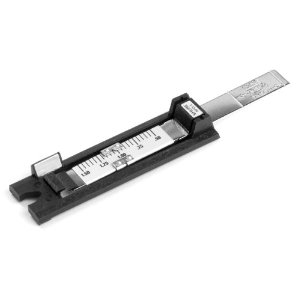A stylus force gauge is an item that comes highly recommended for setting up your turntable. The problem with built in force gauges is that they are often not accurate enough. When you are speaking of fractions of a gram being placed through a needle, a small difference in weight can make a big difference in sound.
What is a stylus force gauge?
A stylus force gauge is an elegantly simple device that is essentially a scale. It measures fine weights, including the weight of a stylus pressing down on to a record. The reason a stylus force gauge is used, instead of another scale (for example a scale for measuring out things to be used in chemistry), is that the weight needs to be measured at the point at which the stylus touches the record.
Any stylus force gauge will have a place at which the turntable needle should be placed, and a gauge. There are both digital and ‘analogue’ gauges, and in my opinion digital ones offer no benefits over standard ones whilst costing more. A cheap and simple stylus force gauge is the Shure SFG-2.
When purchasing a stylus force gauge, make sure that it reads weights that suit your cartridge. Most gauges will read up to around 3 grams, which is plenty, but some cartridges will track heavier than this. This is especially true for specialist cartridges for listening to 78 RPM records.
Finding the Tracking Force For Your Cartridge Using A Stylus Force Gauge
Cartridges will have a recommended tracking force listed in the manual. Otherwise you can find it online. If you don’t know the tracking force, such as if you have an old, unidentifiable cartridge), then aim for 1.5 grams. Adjust the tracking force within the range recommended by the manufacturer according to what pleases your ears.
Further detail about the initial stages of turntable set up can be found here.
Conclusion
A stylus force gauge is a simple device that can improve your turntable set up and allow for a greater deal of accuracy. A stylus force gauge is a cheap, essential piece of equipment for any turntable owner, especially for owners of vintage or audiophile gear.

Leave a Reply